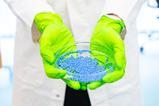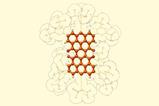Sustainable by design solutions in adhesives usually compromise on strength and stickiness. Now, a group of chemists has created a reversible adhesive, using molecules that quickly ‘click’ and cure with visible light and easily unstick in the microwave. Moreover, most processes are practically solvent-free, further increasing sustainability.
The reversible chemistry of vitrimers, structures with responsive bonds, has inspired adhesive manufacturers to create versatile and recyclable solutions. Some sustainable adhesives have reached everyday household products, such as the sticky paste that bonds beer cans but breaks upon a twist and the electro-responsive polymer that improves the repairability of Apple smartphones. However, most sustainable adhesives still face limitations – from deficient debonding that leaves sticky residues to inefficient recycling reactions requiring high temperatures, dangerous UV irradiation or hazardous solvents.
Here, researchers recognised the potential of a naturally occurring organosulfur compound – alpha-lipoic acid. Although already previously used in sustainable adhesives, the current combination with pentaerythritol in a simple, one-pot process produces a polymer precursor with unique properties. For starters, it quickly cures under violet light, forming a brittle solid that strongly glues glass, aluminium, polycarbonate and FR4, a common composite used in computer chips.
This adhesive also unsticks with a simple stimulus and without solvents – it’s ready to recycle after only 30 seconds in the microwave. Preliminary studies suggest the irradiation alters the structure of carbon–sulfur bonds and triggers depolymerisation in a process that preserves the properties and performance of the adhesive, even after four recycling reactions.
Another advantage is water resistance. The polymerisation reaction works underwater, with similar shear strength to the adhesive synthesised in dry conditions. This suggested the adhesive could work on wet tissues and was tested on chicken skin as a proxy for human skin. The results proved superior to other lipoic-acid adhesives, and similar in strength to commercial cyanoacrylate-based superglues.
References
N Jarach et al, Adv. Mater., 2025, 2502040 (DOI: 10.1002/adma.202502040)









 User Center
User Center My Training Class
My Training Class Feedback
Feedback















Comments
Something to say?
Login or Sign up for free